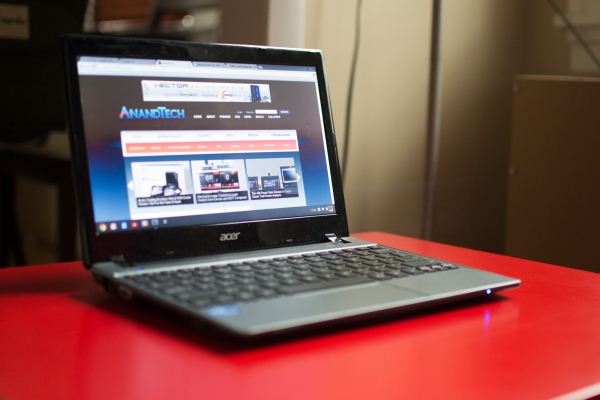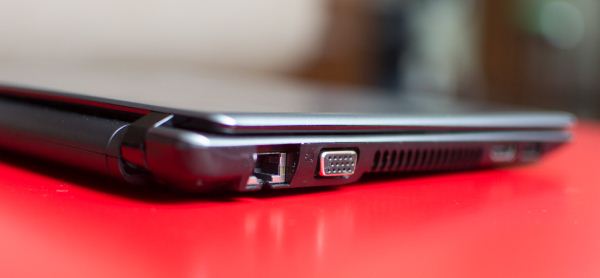Acer C7 Chromebook Review
by Jason Inofuentes on January 21, 2013 12:30 PM ESTIf today we were reviewing the Acer Aspire One A0756-2641 notebook, from which the Acer C7 Chromebook is derived, then it would be really brief. Compromised, and too expensive. Priced at around $329, the spec sheet is spared utter embarrassment by having a low-end Sandy Bridge processor, rather than something from the Atom line. Aside from that, it’s hard to argue in favor of this notebook when a little more cash can net you a small caching SSD, more RAM, a better processor and a goodly performance boost. But this isn’t the Acer Aspire One. This is the Acer C7 Chromebook, and it only costs $199. Does that make all the difference? Let’s take a look.
In consumer electronics, every market segment goes through this moment when the technology becomes affordable enough that it becomes a race to the bottom. The netbook movement pulled the floor out from under notebook prices, and the results were, at first, severely compromised and almost unbearable. The long term result of the ensuing price pressure means a fantastic Windows laptop can be had for well under $1000. Much of this is owed Intel’s fabs (and marketing) and we are in an era of high IPC, power efficient and cheap x86 processors powering notebooks of all shapes and sizes.
The full promise of the netbook was never truly acheived, though. There are no “good enough” Windows notebooks available for under that magic $200 barrier. Today’s Atom lacks the oomph to make the user experience one we’d recommend. Move up to a more modern Intel CPU, though, and you get a better experience, but a higher price. So what happens if you take the aforementioned Acer Aspire One A0756-2641 (a Windows 8 notebook with an 11.6” screen and a Sandy Bridge-based Celeron processor with Intel HD Graphics and a 320GB HDD and 2GB of RAM) but stripped out that Windows license and charged $199 for it?
Let’s talk turkey. Thin, flexible plastic does not inspire confidence, nor does it feel good against your finger tips. That’s something we’ve known for a while, long before the materials experienced a resurgence as the netbook movement really grew its wings and become the benchmark for cheap notebooks. You can make the millimeter thin composites look good, and you can even give it an internal structure that is rigid, but it will always feel cheap.
The Acer C7’s design isn’t terrible. As a color-blind person, I really am much more comfortable around grey-tone products, I never have to worry that I’m secretly wearing purple pants. What kills me is a poor tactile experience. So I was surprised to discover that the cheap plastic forms a pretty solid feeling device. When you hold the chassis in one hand, opened, you can feel the plastic body flexing in your hand, but there’s still enough rigidity that you might be convinced it could survive a short fall. The display’s hinges are solid with no jiggle or dead space, and can be laid nearly flat.
The keyboard is narrower than the best of them, but isn’t so cramped that typing becomes a chore. Proper QWERTY alpha/numeric key placement is a must for me, and here the C7 acquits itself well. The keys themselves are well sprung, if a little shallow, and provide good feedback that they’ve been sufficiently depressed. The directional keys are a bit minuscule, and that can be frustrating, particularly given that you may use them more than the trackpad for making selections.
The touchpad is wider than I expected, and fills nearly the full distance from the keyboard to the edge of the device, but is sadly made of the same cheap plastic as the rest of the body. The result is that, though the body feels solid and the mechanical components are sufficient, there’s just nothing particularly pleasing to touch. The touchpad’s performance is also a bit lacking. Two finger scrolling works well enough, but pinch to zoom was hit or miss and not supporting additional gestures makes it almost impossible to accurately select text or drag a file. For accuracy’s sake I prefer the directional keys, their size not withstanding.
While the base of the C7 tapers down towards the user, the display body is a uniform depth and a bit thicker than I might have hoped. Despite its thickness, with just a mild bit of force you can flex the display pretty radically; not a confidence inspiring trait. Bezels aren’t too radical, and the camera is centered within the top bezels, with the Acer logo below the display.
With the base tapering to a slim edge, the bulk of the laptops weight is in the battery towards the back of the device. Along the bottom of the C7 are myriad vents and labels, and a pair of speaker grills. A single screw beneath a warranty sticker restricts the removal of the bottom panel; and our review sample just happened to be missing that screw entirely. With no screw in the way it’s quite easy to slide the panel off and have access to the hard drive, RAM and wireless module, along with a close look at the cooling mechanism. The left side houses the ethernet and VGA ports on one side of a rather large vent, and HDMI and USB 2.0 on the other. The right side sports the Kensington lock port, power, 2xUSB 2.0 and headset port. Along the front edge are power and charging indicator LEDs, and a sprung SD slot with a molded blank to fill it when the slot isn’t being used.
The C7’s two speakers sit on the beveled edge of the C7, below the wrist rest. Their output won’t rattle your windows, and might not be enough to hear clearly from across the room, but they’ll do from arm’s length.





















63 Comments
View All Comments
Spoelie - Tuesday, January 22, 2013 - link
mhz doesn't matter, it's just a function of architecture on a given process node.With the celeron, you get 15% better cpu performance for 65% of the battery life, which is a pretty lousy showing imo.
On the other hand, at least the GPU is an improvement.
madmilk - Wednesday, January 23, 2013 - link
MHz does matter. Sandy Bridge is not optimized to actively run at 800MHz - its sweet spot is around 3GHz. You pay a huge perf/watt penalty through leakage. An i7 doing the same tasks can go to sleep and power gate in 1/4 the time.BedfordTim - Monday, January 21, 2013 - link
Agreed. I was surprised how close the A15 was. Given the level of development that has gone into x86 processors, you would expect the code to be faster, and the gap should close with time.silverblue - Tuesday, January 22, 2013 - link
I think it could be the case that making an architectural change yields significant benefits, however after you while you'd end up like Intel, spending a huge amount of money to eke out a few more percent. I doubt that the next big step for ARM would be anything like A9 to A15 was.andrewaggb - Tuesday, January 22, 2013 - link
I know when I saw the benchmarks I had to go back and look at the x86 specs. For a second I thought the A15 was way faster than I expected. But then I saw just how crippled the celeron is and everything made sense...JasonInofuentes - Monday, January 21, 2013 - link
Others pointed this out, but the take away from performance a performance standpoint is that if you take the second fastest x86 core designs in the market today, gut them, take out their legs, wrap a chain around their neck and put blinders on them, they're still faster than the fastest ARM Cortex-based SoC on the market today.The big play with A15 is that they have finally reached IPC parity with small notebooks. And while that would have definitely been true 5 years ago when Atom was still fresh and Sandy Bridge was off the edge of Intel's road map slides, it is now not nearly so strong a case. In terms of performance/watt, ARM has done a very very good thing and they should be commended for that. And I have no doubt that a Chromebook equipped with Exynos 5 clocked at 2.3GHz would wipe the floor with the Acer C7. But we're still talking about putting a featherweight champion against a heavyweight punching bag.
We'll explore this relationship a little further, indeed you can get some feel of it in Anand's reviews of the Win8 tablets that have been coming out. Stay tuned.
lmcd - Saturday, January 26, 2013 - link
Hmm, but the graphics are an important point, and it seems like ARM (Mali-series) and Nvidia have a better roadmap there. Maybe a T4 Chromebook could take down an Ivy or Haswell ULP? Or an Exynos-Quad?Worth seeing.
bleh0 - Monday, January 21, 2013 - link
I'll wait till there is a reliable way to put Mint 14 on it. Until then you might as well put money towards the Samsung chromebook.mutatio - Monday, January 21, 2013 - link
Never mind the fact that this product, in similar fashion to the Droid phones, is designed entirely with the focus of mining, harvesting, and exploiting your personal data for their profit. No thank you, Google. Hell, I'll pay the Dell/HP "premium" of a $299 or $399 laptop/ultrabook to avoid that whole arrangement. Mind you, I've already happily paid the Apple premium to have devices focused on my ease of using them rather than the ease of which my information is exploited. Apple has a much better track record in respecting user's privacy, making the disclosure of it voluntary rather than inherent to the products being used.phillyry - Monday, January 21, 2013 - link
That's a good point.It really does seem like Google's dark side is starting to show now that they've got a death grip on the market.
It's like, "Mawahaha, now that we've got you in, we'll just monitor and monetize every aspect of your virtual life. Hahaha!"